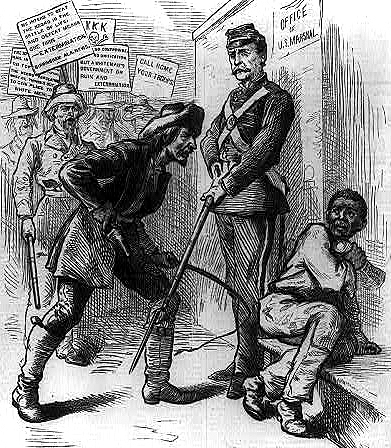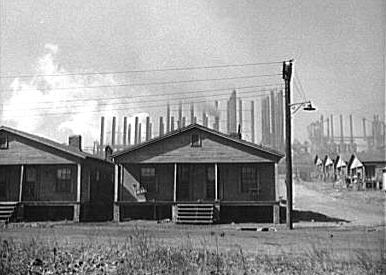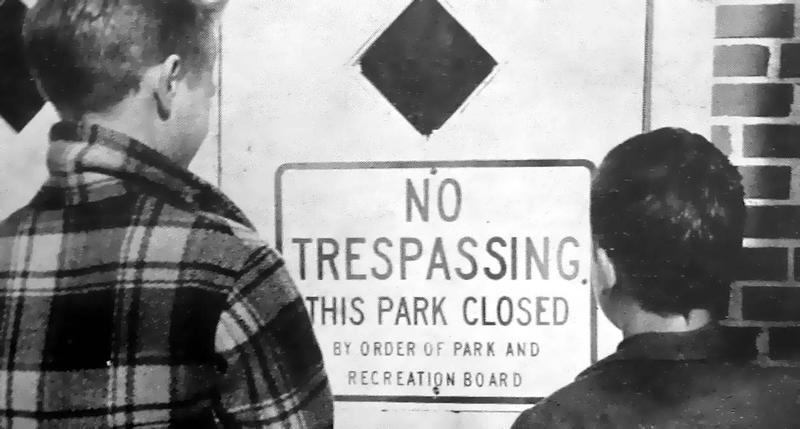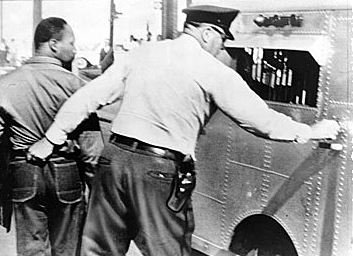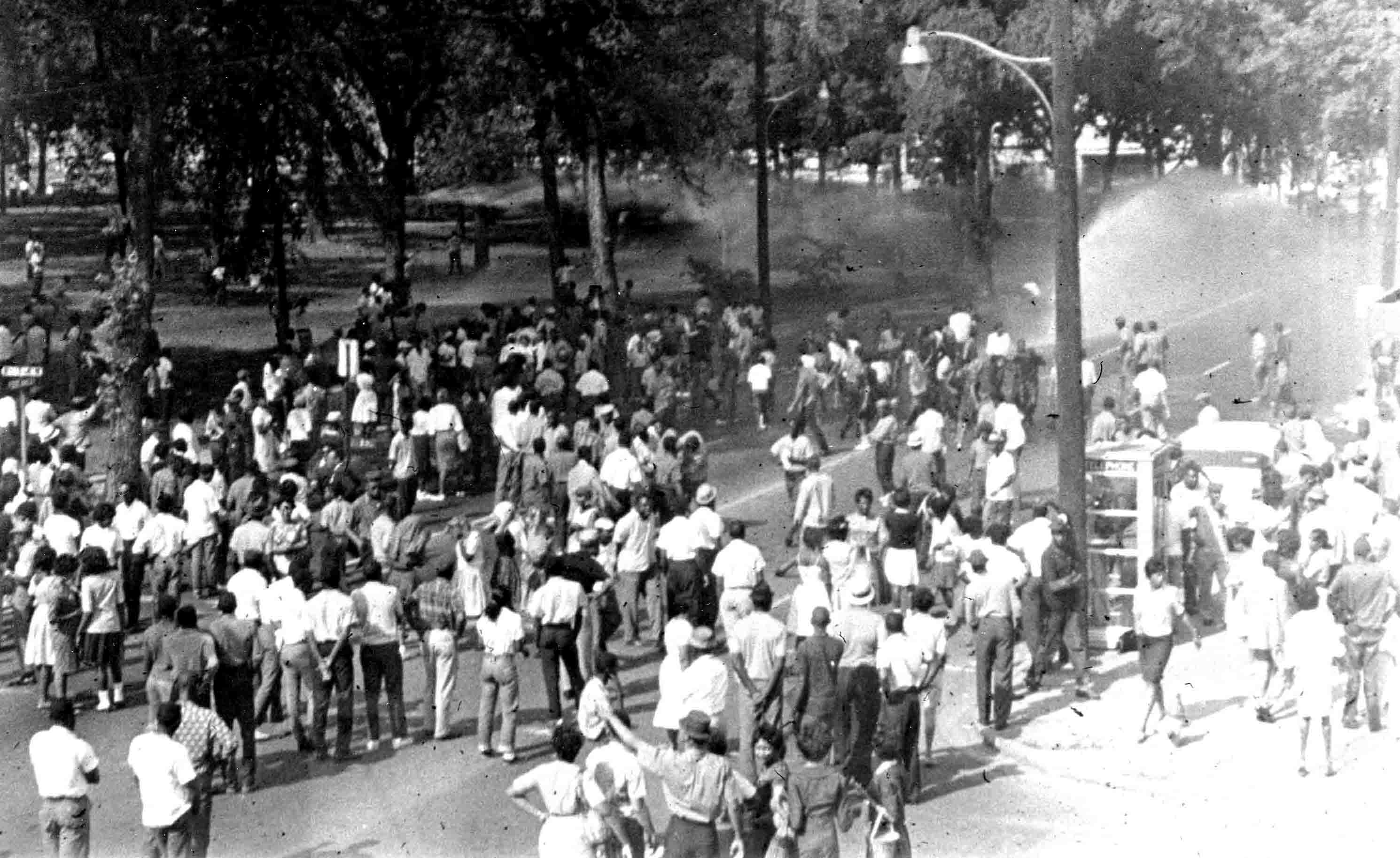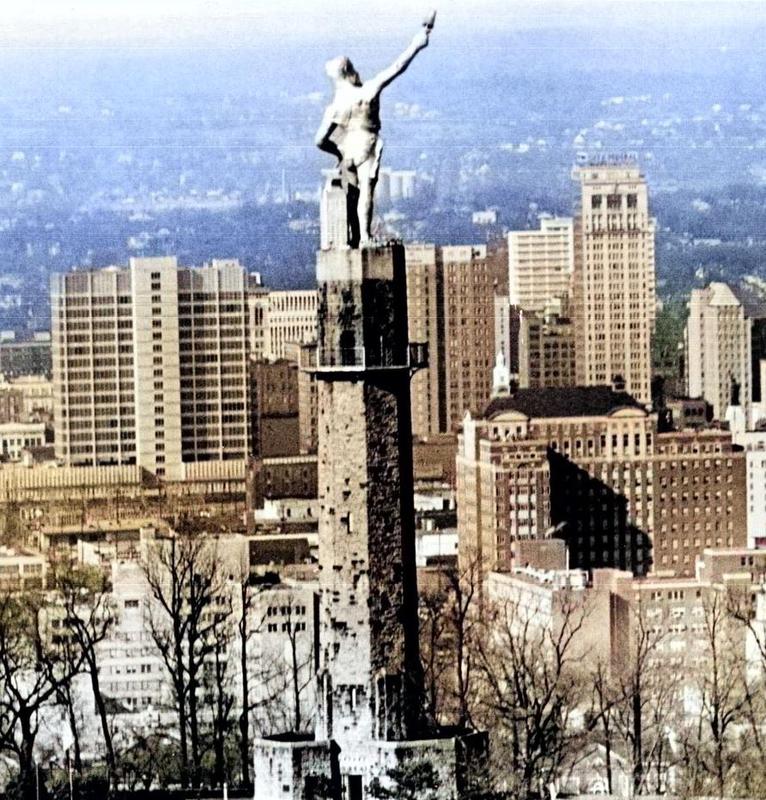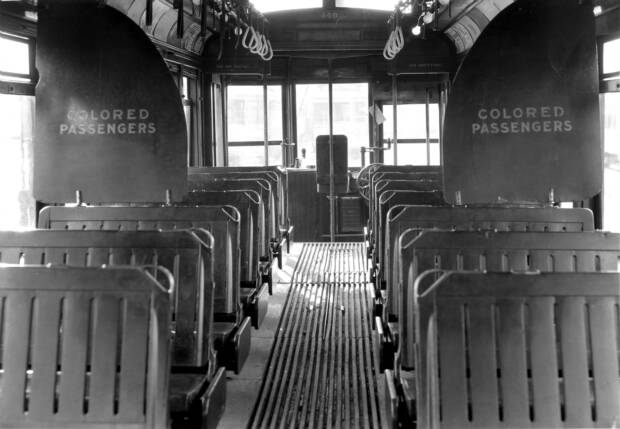Birmingham - A Line in the Sand
Perched high atop Red Mountain overlooking the city of Birmingham, Alabama can be found the fifty-five-foot-high cast iron statue of Vulcan, the Roman god of forge and guardian of the metropolis. Under the steely gaze of Vulcan, the city grew at an incredible rate due to its ability to produce steel. Subsequently dubbed the Magic City, Birmingham’s success was forged in steel while its attitudes were galvanized in segregation. In 1963, Birmingham would bare witness to the forging of a different kind, the civil rights movement.
When exactly did the fight for civil rights start? Was it the Civil War? Reconstruction? The Jim Crow era? The Montgomery bus boycott of 1955? While there is no definitive answer there is no question that the pivot point of the movement were the civil rights marches in Birmingham, Alabama in 1963. Martin Luther King had forced the city of Birmingham into an unwilling corner of decision making. Bow to civil rights demands or Birmingham will suffer under a national spotlight of embarrassment.
"Shall we call home our troops?"
The civil rights movement arose because of the debacle of Reconstruction. Reconstruction was the 10 year period after the civil war designed to help bring the south back into the Union under Union guidance. Union troops occupied the South primarily to help newly freed slaves acclimate themselves to their new life and to see to it that southern authorities followed the constitution.
Without Union troops to enforce this, as the cartoon on the right suggests, ex-slaves would have been doomed.
With the death of Lincoln they were doomed. New president Andrew Johnson was not enthusiastic about helping ex-slaves. Since they owned nothing they were once again dependent on the white aristocracy. When Union troops finally left the South, any civil rights gains slowly disappeared and the South began a downward spiral right back to antebellum days.
For the Reverend Martin Luther King, Birmingham would be his own personal conversion from iron to steel. While Dr. King and his Southern Christian Leadership Conference (SCLC) had made significant civil rights progress (in the South) since its inception in the 1950's, by 1963 momentum was lagging.
King accurately sensed the terrific unrest in the big urban areas he visited. Everywhere were signs that society was on the brink of racial violence. Time was running out for the nonviolent movement. In order to sell his pacifistic schema, he desperately needed a knockout civil rights victory to prove his peaceful methods worked and to diffuse looming riots. Birmingham would be that genesis.
Birmingham was named after the principle industrial town in England. It is one of the few locations on earth that possesses vast quantities of iron ore, coal and limestone, i.e. the ingredients for steel. It would seem Birmingham’s destiny had been chosen for it.
The steel and mining industry which dominated the landscape readily defined the people. The citizens were mentally and physically a very tough group who toiled a dangerous trade for near subsistence wages. The sting of the Civil War still hovered over the South like an ominous shadow, always there, always reminding. Southerners take great pride in the fact that relatives fought with great distinction and bravery during the Civil War. They were sensitive about the federal government dictating policy in the 1800's and the feeling intensified with age. With the arrival of the Civil Rights Movement, old wounds which had never healed properly to begin with, were once again ripped open.
Homes of Birmingham steel workers overlooking the giant Sloss furnaces. With the magic growth of the city came an influx of black immigrants seeking jobs. Between 1910 and 1930 Birmingham gained some 46,000 black residents.
The rapid change and competition for jobs brought immense hostility to the region. With the onset of the Great Depression in the 1930's and subsequent layoffs of the steel industry, that animosity grew. It would reach a peak during the 1960's.
The dynamite bombing of the Sixteenth Street Baptist Church in Birmingham, only months after King’s momentous civil rights victory, further enforced the mentality of “an eye for an eye.” Four innocent
black girls attending Sunday school were killed by the blast and in an instant the country teetered on the brink of a race war. Perhaps an epiphany, all of the stained glass windows were blown out except the
one of Jesus leading young children.
Birmingham served to draw a line in the sand to every big city in the country that action against oppressors was necessary if civil rights were to be obtained. But what type of action against what type of entity? The stage had been set in this war without boundaries. Now it would be the North’s turn to deal with the “black problem.”
The Citadel of Segregation
Martin Luther King arrived in Birmingham in April of 1963 still stinging from the debacle of Albany, Georgia, less than a year previous. Initially King had only planned to make a speech there but a full-fledged demonstration ensued. He attempted to fill the Albany jails with protesters to bring media attention to this racially divided town. Albany Sheriff Laurie Pritchett had other ideas. He had studied King’s methods and refused to be goaded into any violent spectacles. To keep the situation out of the spotlight he had all arrestees shipped to neighboring towns to prevent negative press. To make matters worse, Albany officials agreed to meet with local civil rights leaders on the premise that King left town first. This created some dissension in the ranks. When King finally left town, Albany officials reneged on their promise. King had been duped and his credibility damaged. Another defeat of this magnitude could not be allowed to happen.
Birmingham’s segregated reputation was Albany times ten and Birmingham Sheriff Thaddeus “Bull” Connor was certainly no Laurie Pritchett. Connor was known to have a hair-trigger temper that King calculated could be tripped with the appropriate prodding.
Birmingham was considered by many as the citadel of segregation. The city seemed to be locked in the grips of a Rip Van Winkle slumber since the conclusion of the Civil War. This did not escape the attention of Martin Luther King who, at the behest of a local reverend, was asked to come join the battle against this keystone of injustice. If the keystone falls, all the other stones fall with it. Birmingham was that keystone and Bull Connor represented the mortar.
Birmingham Sheriff Thaddeus Eugene “Bull” Connor was an anachronism in a waning age of segregational chivalry. Elected sheriff in 1957, he vowed to maintain segregation to the best of his ability and within the letter of the law. Now one hundred years after the Emancipation Proclamation, the black man was still oppressed, still in fear and still waiting for the leaders of the country to uphold the Constitution they themselves had sworn to enforce. But Jim Crow would not go easy and many a complicit American city would fall hard with it.
Bull Connor
Between 1957 and January of 1963, Birmingham had some seventeen unsolved bombings. The targets were black homes, black churches and black civil rights leaders. The city eventually earned the cynical nickname of “Bombingham” thanks to the volatile antics of some of its more unstable personalities. Birmingham miners, of which there were many, were well acquainted with the use of dynamite and often very outspoken in their views.
Local reverend Fred Shuttlesworth
stands besides the ruins of his bombed out house. Considered the soul of the Birmingham civil rights movement, he had battled Birmingham segregationists for years and as a result was beaten, stabbed, jailed repeatedly and had his church and home dynamited.
Shuttlesworth had been jailed so many times for civil rights demonstrations he considered it a badge of honor. His fearless perseverance and conviction was a light in the dark days of Birmingham.
Birmingham Reverend Fred Shuttleworth
"I wasn't saved to run."
If you had visited Birmingham before the third of April in the one-hundredth anniversary year of the Negro’s emancipation (1963), you might have come to a startling conclusion. You might have concluded that here was a city which had been trapped for decades in a Rip Van Winkle slumber; a city whose fathers had apparently never heard of Abraham Lincoln, Thomas Jefferson, the Bill of Rights or the Preamble to the Constitution.
If your powers of imagination were great enough, you would picture your life in the following manner: You would be born in a Jim Crow hospital to parents who probably lived in a ghetto. You would attend a Jim Crow school. You would spend your childhood playing mainly in the streets because the “colored” parks were abysmally inadequate. When a federal court order banned park segregation, you would find that Birmingham closed down its parks and gave up its baseball team rather the integrate them.
If you were hungry or thirsty, you would have to wait until you got back to the Negro section of town, for in your city it was a violation of the law to serve food to Negroes at the same counter with whites. If you believed your history books and thought of America as a country whose governing officials are selected by the governed, you would be swiftly disillusioned when you tried to exercise your right to vote. You would have found a general atmosphere of violence and brutality in Birmingham where the silent password was fear.
You would be living, in fact, in the most segregated city in America.
The Birmingham of 1963 was a city saturated with fear. Blacks feared attempting to vote, blacks feared mixing with whites, blacks feared the KKK and most certainly, blacks feared their own government. For Birmingham blacks the discrimination was across the board, including segregated city parks. When a federal court ordered Birmingham to desegregate the parks, Bull Connor closed the parks to everyone and saw its minor league baseball team leave town rather than integrate.
Birmingham had become a segregational maze. Robotic-like blacks simply followed the Jim Crow signs, “Colored Hotel,” “Colored bathroom,” “Colored section,” “Whites Only.” Moderate whites in sympathy with blacks were also kept “in their place” and forced to tow the segregated line. The civil rights bill that Kennedy had supported died amidst a still unresponsive Congress. Blind to the upheaval segregationists had produced, it would take the ugly revolt of Birmingham to jog their conscience into action. By then it would be too late, for once the avalanche of hatred got rolling in the North, there would be no stopping it.
Project "C"
Dr. King and his lieutenants had devised a grand scheme to “attack” Birmingham. To drive the point home it was dubbed Project “C” for confrontation. The confrontation, it was hoped, was to come from the authorities. King well knew the volcanic atmosphere amassing in ghettos across the country. If he could win a peaceful victory in Birmingham he stood a chance not only of providing a much needed hope to the underclass but of staving off future riots.
"You don’t win against a political power structure
As King prepared to march, yet another chapter in the Birmingham saga was unfolding. The city had voted to replace its city-commission type of government with a strong-mayoral form. The two leading candidates, as luck would have it, were Albert Boutwell and Bull Connor. The civil rights marches and sit-ins were begrudgingly postponed, lest King give Connor any fodder for his political canon. Although Boutwell won the election, Connor filed suit that under the previous form of government he was still the sheriff, so for the interim Connor not only kept his job but essentially had no boss to dictate policy. He was, in effect, a lame duck dictator and subsequently had little reason to show restraint.
Starting April 6th with a march on City Hall, the demonstrations and sit-ins grew in intensity. In the meanwhile, the Birmingham city jail slowly filled. Initially Sheriff Connor maintained a policy of civility towards the marchers hoping the problem would go away. To thwart them, the city obtained a court injunction on April 10th preventing further marches. King, normally compliant with such orders, now chose to disobey and was summarily thrown into solitary confinement for eight days. The fact that it was Good Friday added a spiritual significance. Birmingham was unwittingly becoming the center stage for this drama that was rapidly unfolding before a national television audience.
King being led to jail.
On April 20th King’s exile finally ended with much fanfare. From President Kennedy on down, all eyes were now thrust on Birmingham. Anxious to restart the marches, King was crestfallen to find that his army of protesters had dwindled to a solitary platoon. Adults were being pressured with dismissal from their jobs, the lone contingency they had stated ahead of time they could not sacrifice. King suddenly had no finale to produce.
Over at the high schools, however, King’s inflamed rhetoric of the previous weeks had not fallen on deaf ears.
Teenage students by the hundreds leaped at the chance to make history. King agonized over the decision but history had taught him that “freedom is never voluntarily given by the oppressor; it must be demanded by the oppressed.” King understood the terrific risk involved if any of the kids got hurt, but he had manufactured a great hope and expectation for Birmingham, and with the specter of another Albany looming he dared not disappoint. Blacks had been told since the end of the Civil War to wait, be patient, only to realize that “wait” had become the replacement word for “never”. By the 1960's they could wait no more.
As May 2nd dawned on Birmingham, the aroma of the freshly bloomed magnolias, a local favorite, drenched the air with the arrival of spring. It would be the last familiar glimpse of normalcy for some time. King now had an adolescent army of one thousand strong. As they enthusiastically marched down Birmingham’s turbulent streets, an enraged Bull Connor ordered them all jailed. All in all, nine hundred were incarcerated.
On May 3rd, much to Connor’s indignation, some 2,500 teenagers showed up. Connor was livid. He ordered the water canons turned on and the raging police dogs brought in. The crowd scattered with the canines in hot pursuit. Back in Washington, President Kennedy, who was watching the spectacle unfold on television, was appalled. He dispatched assistant Attorney General Burke Marshal to Birmingham in hopes of bartering a peaceful solution.
Kelly Ingram Park - With water canons blazing, the final showdown begins
For the next week King was relentless with his marches. As a thousand protesters were sequestered in jail, another two thousand replaced them. Connor was stymied by the turn of events. By May 10th even the Birmingham firemen were questioning the validity of their actions. Local business leaders, many of whom were avowed segregationists, were mortified at the media circus that had unfolded before the nation.
Their beloved Birmingham was caught in the naked spotlight for all to see the dirty little secret of Jim Crow. Both sides finally agreed to meet and an accord was reached phasing out Jim Crow lunch counters and restrooms and to begin hiring blacks in local stores. For the time being King had won the historic civil rights victory he set out to gain. But was it a hollow victory?
Birmingham Civil Rights Demonstrations - 1963
